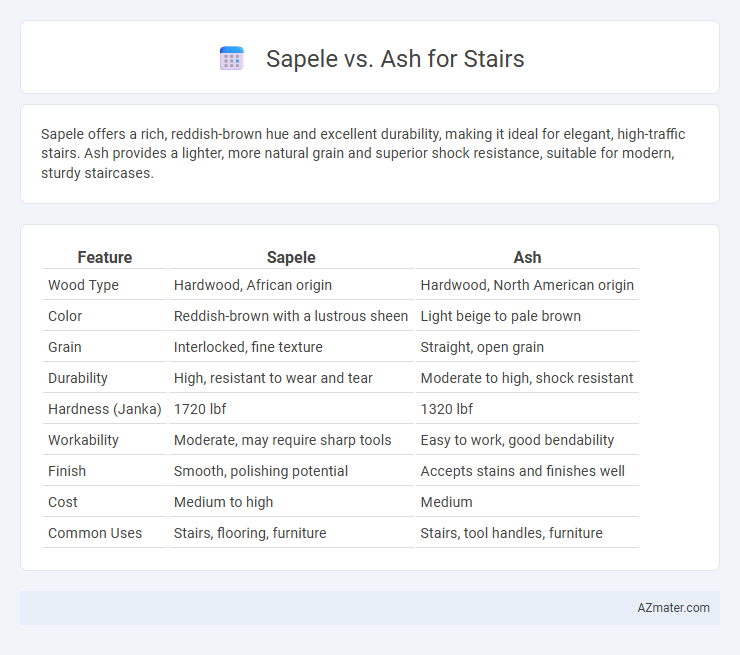Sapele offers a rich, reddish-brown hue and excellent durability, making it ideal for elegant, high-traffic stairs. Ash provides a lighter, more natural grain and superior shock resistance, suitable for modern, sturdy staircases.
Table of Comparison
| Feature | Sapele | Ash |
|---|---|---|
| Wood Type | Hardwood, African origin | Hardwood, North American origin |
| Color | Reddish-brown with a lustrous sheen | Light beige to pale brown |
| Grain | Interlocked, fine texture | Straight, open grain |
| Durability | High, resistant to wear and tear | Moderate to high, shock resistant |
| Hardness (Janka) | 1720 lbf | 1320 lbf |
| Workability | Moderate, may require sharp tools | Easy to work, good bendability |
| Finish | Smooth, polishing potential | Accepts stains and finishes well |
| Cost | Medium to high | Medium |
| Common Uses | Stairs, flooring, furniture | Stairs, tool handles, furniture |
Introduction to Sapele and Ash as Stair Materials
Sapele, a durable African hardwood with a fine texture and reddish-brown hue, offers excellent strength and stability ideal for stair construction. Ash, known for its light color and prominent grain pattern, provides superior shock resistance and flexibility, making it a popular choice for both modern and traditional stairs. Both materials excel in wear resistance and can be finished to enhance their natural beauty, ensuring long-lasting staircases with distinct aesthetic appeals.
Origin and Characteristics of Sapele Wood
Sapele wood, primarily sourced from West Africa, is renowned for its rich reddish-brown color and distinctive interlocking grain, offering excellent durability and resistance to wear, making it a popular choice for staircases. Its natural luster and fine texture provide a sophisticated finish compared to ash, which is typically lighter in color, originating from North America and Europe, and known for its straight grain and flexibility. Sapele's high-density hardness and resistance to rot make it superior for high-traffic stair applications where longevity and aesthetic appeal are crucial.
Origin and Characteristics of Ash Wood
Ash wood, primarily sourced from North America and parts of Europe, is renowned for its strength, elasticity, and light color, featuring a straight grain and coarse texture ideal for stair construction. It offers excellent shock resistance and a smooth finish, making it suitable for high-traffic areas like staircases that demand durability and aesthetic appeal. Compared to Sapele, which is a tropical hardwood from West Africa with rich reddish tones, Ash provides a lighter, more versatile option known for its workability and wear resistance.
Durability Comparison: Sapele vs Ash
Sapele wood offers superior durability for stairs due to its high density and natural resistance to wear, making it less prone to dents and scratches compared to Ash. Ash, while durable and flexible, tends to show signs of wear more quickly under heavy foot traffic because it is softer than Sapele. For stair applications requiring long-lasting resilience, Sapele provides better performance in maintaining structural integrity and aesthetic appeal over time.
Aesthetic Differences: Color, Grain, and Texture
Sapele staircases exhibit a rich, reddish-brown hue with interlocking grain that creates a striking ribbon-like pattern, offering a smooth, lustrous texture that deepens over time. Ash, in contrast, presents a lighter, creamy to pale brown color with straight, pronounced grain lines, providing a more uniform, coarse texture that highlights its natural wood structure. The visual warmth and complexity of Sapele make it ideal for luxurious, classic stair designs, while Ash suits modern, minimalist aesthetics due to its bright, clean appearance and bold grain.
Workability and Installation Ease
Sapele offers excellent workability due to its moderate hardness and fine grain, making it easy to cut, shape, and finish for stair applications. Ash provides superior installation ease thanks to its straight grain and uniform texture, which reduces splitting and sanding time during stair construction. Both woods are durable, but Ash's lighter weight and flexibility can simplify handling and fitting in staircase projects.
Cost and Budget Considerations
Sapele offers a rich, reddish-brown hue and hardwood durability at a moderate price, making it a cost-effective choice for staircases within mid-range budgets. Ash tends to be lighter in color and generally more affordable, providing a budget-friendly option without compromising strength and wear resistance. Considering long-term value, Sapele may incur slightly higher upfront costs but offers enhanced aesthetic appeal, while Ash remains suitable for cost-conscious projects prioritizing function over luxury.
Maintenance Requirements for Staircases
Sapele wood requires moderate maintenance for staircases, needing regular cleaning and periodic oiling to maintain its rich color and prevent drying or cracking. Ash, known for its durability, demands less frequent upkeep but benefits from occasional polishing to preserve its natural light finish and resist wear. Both woods respond well to preventative care, though Sapele's higher oil content demands vigilance to avoid surface dullness caused by dirt buildup.
Environmental Impact and Sustainability
Sapele wood, sourced primarily from West Africa, is often considered more sustainable due to the presence of certified plantations and efforts to reduce illegal logging, whereas ash, native to North America and Europe, benefits from established reforestation programs promoting responsible harvesting. Both woods are biodegradable and recyclable, but ash has a faster growth rate, making it a more renewable option in temperate climates. The environmental impact of Sapele is higher when sourced unsustainably, while ash generally offers lower carbon footprints when harvested from managed forests.
Best Applications: Which Wood Suits Your Stairs?
Sapele offers rich, reddish-brown hues and exceptional durability, making it ideal for high-traffic staircases requiring both elegance and strength. Ash boasts a lighter color with a straight grain pattern, providing a more contemporary look and excellent shock resistance, perfect for modern stair designs that emphasize brightness and resilience. Choosing between Sapele and Ash depends on whether your priority is luxurious aesthetics with robust hardness or a lighter, adaptable wood with superior flexibility for stairs.

Infographic: Sapele vs Ash for Stair
 azmater.com
azmater.com